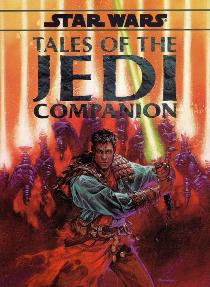
Into the Unknown
| An analysis
of the various factors, both natural
and political, that may have contributed to the slow expansion of the |

The idea that only an enlightened civilization can develop faster-than-light space travel and colonize a galaxy is a favorite one amongst sci-fi enthusiasts. It can find its roots in the sometimes-rosy optimism of such notable people as H.G. Wells, believing science will eventually bring about an age of rationalism and create an utopia for mankind. There is little support for that idea in Star Wars, however. Indeed, there is little historical support for that idea. Many years have passed since the death of Wells and the Earth is still as stained by greed and ambition as ever. It is at least as likely as not that we will still take our petty disputes with us into the age of space colonization as well.
History has shown that expansionist policies do not immediately mark the death of any government. Though it can eventually lead to the dissolution of a government, it may take years or centuries for that dissolution to come. As long as the government has the resources and means to continue its expansionist policies, pleases its primary citizenry, and creates policies to wisely manage its possessions, it can continue it can continue. Admitting this, we should conclude that with the resources of a galaxy to plunder, an expansionist government could continue for a very long time indeed. This means that there is no compelling reason to believe that all space-faring civilizations in the Galaxy Far, Far Away were enlightened enough to see the advantages of working together. In fact, the civilizations of many races probably attempted to gain power at the expense of the welfare of other races. As with the interaction between planetary governments, governments of a galactic scale should be no different if one believes that greed would be common to all species, whether they be mammalian, reptilian or otherwise. Greed is, after all, a very natural instinct, the instinct that drives a species to attain everything it can possibly attain in order to just survive and not worry about being at a disadvantage compared to other species. Even among humans, the instinct is only overcome after much discipline. No doubt it would be a powerful instinct for other sentient species throughout the Star Wars Galaxy. It is an instinct that would certainly put interstellar governments at odds with each other.
What supporters of the idea that civilizations of the Galaxy, Far, Far Away are enlightened and non-confrontational are trying to have us swallow goes against all common sense and observation. No equilibrium in which most beings and the governments that they run are satisfied with their status has ever existed. History has shown us that the trend is to grab more power, usually at the disadvantage of other people and governments. It is therefore reasonable to assume that the interaction of various governments also played a role in the expansion of the Republic. There is no reason to assume that as the Old Republic was expanding from its birthplace in the Core, it did not also encounter opposition from other governments as large as itself, or perhaps larger; governments that were perhaps founded by non-human species or even humans that had goals that ran counter to that of the humans who founded the Old Republic. The primary opposition to the human founded government were quite possibly the governments established by alien species. Humans have a difficult enough time finding enough common ground to avoid hostilities, it is not hard to imagine that when dealing with alien species, the task of finding common ground would be magnitudes more difficult. After all, the cultures of sentient alien species would have evolved completely independently from that of humans, sometimes with no undercurrents of familiarity and similarity whatsoever, as the cultures would be developed under the guidance of different biological drives and imperatives. What can be found to be important in most human cultures may not have any importance in most alien cultures. Would an insectoid alien species that valued a hive-mind civilization value individuality as much as humans? Would they not believe that their way of living is superior to all forms of social orders? Would some of these insectoid species not feel that it is their responsibility to see their way of life flourish? Space-faring alien governments that this hypothetical insectoid species already established would not likely appreciate a new upstart human government expanding throughout the cosmos, spreading its “alien” values and morals and becoming a possible threat. Governments would set up barriers, political and military, in an attempt to contain the fledgling Republic. The presence of the fledgling Republic would also unite governments previously in conflict with each other against it. It could take years to usurp the positions of these already established governments. Thousands of years if we are speaking of a galactic scale.
 We know that
such governments existed in the
Star Wars Galaxy. According to the New
Essential Chronology, a rival human-dominated government was
founded in the
Tion Cluster of the Galaxy Far, Far Away hundreds of years before the
Republic
was forged (Wallace and Anderson 4). The Tionese had even developed a
form of
hyperdrive not dependent on the hyperspace cannon network that worlds
of the
galactic Core used. This hyperdrive was developed years before the
Republic
developed a similar type of technology. Even after the Hutt Empire
halted the
expansion of the Tionese with military force, the Tion still remained a
power
to respect, well after the Republic was founded. The Tion eventually
declared
war on the Republic. The respective capitals of the two worlds were
bombed
during this war. The Republic declared victory when its agents stirred
up
trouble in the Hutt Empire causing it to take out its wrath on the
Tionese. (Presumably
the Republic framed the Tionese, making them appear responsible for
whatever
was done to the Hutts.) The then powerful Hutt Empire declared war on
the Tion
Cluster and within a century most of the Tion Cluster had joined the
Republic
so that it could be protected from the Hutts (6). Here we see an
example of politics,
the conflicts between governments limiting the expansion of the
Republic. For
seven thousand years, the space the Tionese controlled was not a part
of the
Republic. It was only in the aftermath of the Tion/Republic war that
the
borders of the Republic expannded to include the Tion Cluster.
We know that
such governments existed in the
Star Wars Galaxy. According to the New
Essential Chronology, a rival human-dominated government was
founded in the
Tion Cluster of the Galaxy Far, Far Away hundreds of years before the
Republic
was forged (Wallace and Anderson 4). The Tionese had even developed a
form of
hyperdrive not dependent on the hyperspace cannon network that worlds
of the
galactic Core used. This hyperdrive was developed years before the
Republic
developed a similar type of technology. Even after the Hutt Empire
halted the
expansion of the Tionese with military force, the Tion still remained a
power
to respect, well after the Republic was founded. The Tion eventually
declared
war on the Republic. The respective capitals of the two worlds were
bombed
during this war. The Republic declared victory when its agents stirred
up
trouble in the Hutt Empire causing it to take out its wrath on the
Tionese. (Presumably
the Republic framed the Tionese, making them appear responsible for
whatever
was done to the Hutts.) The then powerful Hutt Empire declared war on
the Tion
Cluster and within a century most of the Tion Cluster had joined the
Republic
so that it could be protected from the Hutts (6). Here we see an
example of politics,
the conflicts between governments limiting the expansion of the
Republic. For
seven thousand years, the space the Tionese controlled was not a part
of the
Republic. It was only in the aftermath of the Tion/Republic war that
the
borders of the Republic expannded to include the Tion Cluster.We are given another example of shifting borders in the Star Wars movies themselves. In The Phantom Menace, Tatooine is in the possession of the Hutts and resides in Hutt space. However, by the time of the Galactic Empire in A New Hope, the Hutts have apparently lost official political control of Tatooine. While the Hutts still operate as crimelords and direct many of their operations from the planet, Tatooine seems to officially be under the authority of the Empire and is within Imperial space. Maps of the Star Wars Galaxy seem to confirm this apparent shrinkage of Hutt territory, as Tatooine is well outside Hutt borders on official maps.
Another hostile government that formed outside of the Republic is the nefarious clan government of the Mandalorians. The Mandalorians apparently amassed enough military might four thousand years before the Battle of Yavin that they were able to conquer a vast expanse of territory outside Republic space. They then used the resources of that territory to launch a war of conquest against the Republic. According to one oif their top tactical advisors who later became Mandalore, leader of the Mandalorian clans, the Republic only outnumbered the Mandalorians five to one in the Mandalorian Wars (Knights of the Old Republic PC Game). The Republic certainly did not have that much of an edge when it came to the numerical strength of their military, indicating that the size of Mandalorian space must not have been inconsiderable in order to field such a large force. These facts show there was a large swathe of space under the control of governments other than the Republic up until four thousand years before the Empire.
Another factor that would have cemented resistance to the expansion of the Republic is when it came under the control of a theocratic sect thanks to the influence of Supreme Chancellor Contispex. Contispex sanctioned a number of crusades against alien species in the Outer Rim of the Galaxy (7). This could have possibly caused many governments to band together to oppose the Republic, and could have caused a number of Republic controlled planets to secede on moral grounds.

During the Imperial era, it is obvious this system is no longer in use. Instead, navicomputers are placed on board each starship. A navicomputer contains astronomical coordinates and performs the calculations required in order to travel through space, operations that millennia ago were performed by jump beacons. There is no reason why the Republic four thousand years before Yavin did not also rely on navicomputers. It could not have been related to cost. Surely, after twenty-one thousand years, navicomputers could be acquired at cheap prices. It is known that navicomputers were in use five thousand years before the Battle of Yavin, but only licensed hyperspace explorers have been observed using them. So the question is, why does the majority of the Republic use jump beacons? It is known that the Chiss Ascendancy uses a similar jump beacon system, designed to control its citizenry. It is possible that the Republic used their jump beacon system for the very same purpose: to limit the exploration of new territory by private organizations, and thus limit the expansion of the Republic, making it more easily controllable. The Republic would be allowed to license as many hyperspace explorers as it wanted to, but always it would license just enough. It would also be able to grant special dispensations to favored corporations, allowing their vessels to have navicomputers so that they could conduct limited exploration programs in search of new resources. As per the implication of the Tales of the Jedi Companion, the hyperspace jump beacon system would have eventually fallen into disuse as the territory of the Republic grew to be too unwieldy. Such abandonment of the jump beacon system was probably encouraged by megacorporations that desired unrestricted movement throughout the Republic and unrestricted exploration of the greater galaxy as resources in the Republic began to dry up after twenty-five thousand years of usage.
 We near the
end of our analysis of the
objections of the Halo Hypothesis. We have but two more objections to
address.
The first of these is concerned with the role of technology in
exploration.
Halo hypothesis supporters often ask how any part of the galaxy can
remain
“unknown.” Even our primitive telescopes can spot stars light years
away. By
studying the UV spectrum of a star, we can even determine what elements
are
contained in a star, since elements emit certain colors that will show
up when the
light of a star is analyzed through a prism. This method, Halo
Hypothesis
supporters contend, should show the Republic what systems have valuable
resources. This is certainly true, however it would tell the Republic
nothing
about the cultures or political situations of interstellar nations that
may
rule those systems, nor could it tell them if those nations possessed
any
significant military might. To illustrate this, let us revisit the
scene in Attack of the Clones in which Obi-Wan is
searching for Kamino in the Jedi Archives. The archives could have an
exhaustive topographical record of the Unknown Regions, but without
knowing
anything about the societies that inhabit the systems of the Unknown
Regions,
the knowledge would be useless. Let us suppose that Kamino is in the
Unknown
Regions. How could the archive stewardess know that a star labeled
A/23GI/F8945
is called “Kamino” by its inhabitants and is the center of a cloning
industry? She
doesn’t, explaining perhaps how Kamino is basically an unknown variable
in an
Unknown Region. Of course, probes and droids could always help with
that
problem, which leads us to the second objection of Halo Hypothesis
supporters.
We near the
end of our analysis of the
objections of the Halo Hypothesis. We have but two more objections to
address.
The first of these is concerned with the role of technology in
exploration.
Halo hypothesis supporters often ask how any part of the galaxy can
remain
“unknown.” Even our primitive telescopes can spot stars light years
away. By
studying the UV spectrum of a star, we can even determine what elements
are
contained in a star, since elements emit certain colors that will show
up when the
light of a star is analyzed through a prism. This method, Halo
Hypothesis
supporters contend, should show the Republic what systems have valuable
resources. This is certainly true, however it would tell the Republic
nothing
about the cultures or political situations of interstellar nations that
may
rule those systems, nor could it tell them if those nations possessed
any
significant military might. To illustrate this, let us revisit the
scene in Attack of the Clones in which Obi-Wan is
searching for Kamino in the Jedi Archives. The archives could have an
exhaustive topographical record of the Unknown Regions, but without
knowing
anything about the societies that inhabit the systems of the Unknown
Regions,
the knowledge would be useless. Let us suppose that Kamino is in the
Unknown
Regions. How could the archive stewardess know that a star labeled
A/23GI/F8945
is called “Kamino” by its inhabitants and is the center of a cloning
industry? She
doesn’t, explaining perhaps how Kamino is basically an unknown variable
in an
Unknown Region. Of course, probes and droids could always help with
that
problem, which leads us to the second objection of Halo Hypothesis
supporters.Halo Hypothesis supporters are quick to remind us that a civilization as advanced as that in the Galaxy Far, Far Away should have no problem exploring the galaxy with probes and increasing the rate of colonization with droids. They need only to send probes out to explore the galaxy and get a lay of the land. Construction droids can be sent ahead of the expanding borders of the Republic and prepare new worlds for colonization well before any sentient organic beings arrive to take possession of those planets. This theory neglects two things. First, it neglects the fact that other governments may not like probes scouting their space and would definitely not like droids building colonies for impending human colonization. It may, after all, be rather difficult for a probe to determine whether a deserted planet was claimed by a foreign government or not. Many governments could see any attempted colonization of that planet as an act of aggression and thus an act of war. Any such colonization methods would have to be used with extreme caution which would effectively limit the effectiveness of those methods.

If strife did not come from outside the Republic, it
would have come from within; if not from within then from without, from
other
governments. Considering that the Star Wars Galaxy has over a million
different
species, many having populations numbering in the trillions or more,
those
populations having different political and religious sub groups, and
those
political and religious sub groups being even further divided into
smaller
groups, is it any wonder that the Republic took twenty-five thousand
year to
engulf the majority of the galaxy? Technology would not be the deciding
factor,
but progress in the interaction between the various species of the
galaxy would
be. In his book Intellectual Morons,
author Daniel J. Flynn quotes social theorist Eric Hoffer. Though
Hoffer refers
to humans, his thoughts should apply to the unpredictable nature of any
advanced sentient race, such as the ones found in Star Wars. Hoffer
states,”To
make of human affairs a coherent, precise, predictable whole one must
ignore or
suppress man as he really is. It is by eliminating man from their
equation that
the makers of history can predict the future, and the writers of
history can
give pattern to the past.” Flynn elaborates the point by stating,
“Systems fail
because the notion of a single idea directing, ordering, and planning
the lives
of vast numbers of people is an absurd one. Human beings are too
independent,
and the fact that there are more than six billion of us makes applying
one
system to all of mankind an idiot’s endeavor.... The same impulse that
pushes
men to believe arrogantly that a system can plan the affairs of whole
nations
leads them to think that a theory can explain all of history.
Single-bullet
theories of history rarely pan out. The
attraction of such explanations is their simplicity (emphasis
mine). They
relieve adherents from any obligation to think. The answers are
preordained.
‘Human nature,’ sociologist Raymond Aron reminds us, ‘is not very
amenable to the
wishes of the ideologists’” (Flynn 4-5).
Supporters of
the Halo Hypothesis should be
content with one thing. Four thousand years before the battle of Yavin,
the
Republic encompassed only a quarter of the Star Wars Galaxy. With the
discovery
of the Perlemian Trade Route, the Republic expanded exponentially,
seemingly
without the interference of any competing foreign governments or any
natural
barriers. Despite the fact that its borders shrunk briefly two thousand
years
before the Battle of Yavin, by the time of Attack
of the Clones, the Republic encompassed eighty
percent of the galaxy. In three thousand years, the Republic went from
controlling a quarter of the galaxy, to controlling eighty percent of
it. Fifty
one years after Attack of the Clones,
over eighty-five percent of the galaxy had been explored and/or
settled,
leaving only fifteen percent of the galaxy with the label Unknown
Regions. This
is an incredible rate of expansion and does seem to support the idea
that had
the Republic encountered no political or natural barriers twenty-five
thousand
years ago, it would have colonized the entire galaxy within a few
thousand
years, possibly only a few centuries. It should be noted that the main
factor
that keeps the successor to the Galactic Republic, the Galactic
Federation of
Free Alliances, from spilling into the remainder of the Unknown
Regions, is the
fact that it is not known how much of the territory is claimed by
possibly
hostile territorial interstellar nations such as the Chiss Ascendancy
which,
though small, guards its borders jealously. Once again, the human
element comes
into play and slows what should be the speedy expansion of an advanced
civilization.
A
Note on this Essay
As you have no doubt noticed, this
essay
does not source all its material. This is mainly because most of the
material
about the idea this essay is meant to refute comes from personal
conversations
with people who support it and from Star Wars message boards across the
net.
There is, to this author’s knowledge, no “official” fan article or
essay that
puts the Halo Hypothesis in a coherent form. That is, there is no one
fan site
that can claim to have written the essay that “started it all.” The
halo idea
got its start on Star Wars message boards some time ago and has grown
since
then. It has been the observation of this author that most of its
adherents hold
at least one of the ideas I mentioned as being a part of the Halo
Hypothesis to
be true. Sometimes they hold several or all the ideas to be true. This
essay is
meant not only to be an objection to those ideas, but it is also
intended to
present alternative explanations for the existence of the Unknown
Regions.
You may also notice that this essay
does
not list the Star Wars movies in its bibliography. This is because this
author
assumes that most readers will have at least a passing familiarity with
the six
Star Wars films and the majority will have watched all six films. If
some of
the readers are not Star Wars fans and have no knowledge of the movies,
then
this author is perplexed as to why a non-fan would even take the time
to read
this behemoth.
This essay was completed on
The characters, devices, and
situations
mentioned in this essay are the creative property of George Lucas and
Lucasfilm
Ltd. This essay is in no way authorized by him or his company.
This author would like to dedicate
this
work to his new wife, Leah Marie Coe. I love you, babe.
This author would like to thank Abel
Pena
for inviting me to write this essay. You can also blame him if you feel
it’s an
unnecessary twenty-one page horror unleashed upon the internet. ;)
This author would also like to thank
Julius Nile “Ulic” Sykes. When one reads your articles, one realizes
that the
full potential for developing the Star Wars universe has not yet been
realized.
Finally, this author would like to
George
Lucas for providing us with such interesting ways to waste our time.
This author realizes that he likes to use the phrase this author....
Bibliography
Flynn, Daniel J.. Intellectual
Morons.
Gibson, John. Hating
STAR WARS is ®,TM, and © Lucasfilm,
Ltd.
(LFL)
All Rights
Reserved.
This site is for entertainment purposes
only.
Please don't sue us!